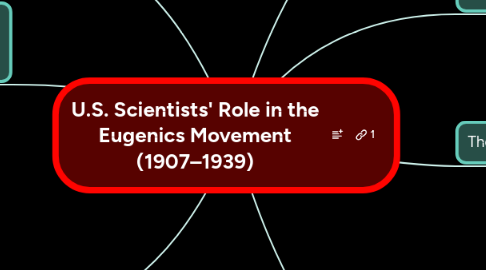U.S. Scientists' Role in the Eugenics Movement (1907–1939)
by Pyros Govoni


1. In 1925, T.H. Morgan attacks Davenport's and Laughlin's approach (without mentioning their names).
1.1. Pointing out that despite all their exhaustive family pedigrees.
1.2. They failed to really understand the nature of the trait they thought they were studying.
2. Within the U.S. and European scientific communities these ideas were not fringe but widely held and taught in universities.
3. Society should promote the marriage of the fittest individuals by providing monetary incentives.
3.1. Many intellectuals and political leaders accepted that modern societies should promote the improvement of the human race through various forms of governmental intervention.
3.2. Promotion of selective breeding and intellectual underpinnings.
3.2.1. State-sponsored discrimination
3.2.2. Forced sterilization
3.2.3. Genocide
4. 1902 | Charles B. Davenport
4.1. Requested to the Carnegie Institution $45,000 to create a "Biological Experiment Station for the study of evolution" on the Cold Spring Harbor Campus.
4.2. Analytic and experimental study of the causes of specific differentiation / of race change.”
4.3. The study of the laws and limits of inheritance.
4.4. Commingles Mendel's scientific genetic approach with his personal fascination with the human racial differences of his time.
4.5. The Experimental Evolution Department had established over 100 animal stocks.
5. In 1920s, 3 major efforts pushed the eugenic agenda in the United States
5.1. The Eugenics Research Association.
5.1.1. In affiliation with the American Association of the Advancement of Science (AAAS).
5.2. The American Eugenics Society.
5.2.1. With the purpose of promoting the eugenical movement at both the scientific and popular level.
5.3. The Eugenics Records Office.
5.3.1. With the purpose of providing the scientific data to support the eugenics movement.
6. The Nazis
6.1. One of Hilter's first acts was the passage of the Law for the Prevention of Hereditarily Diseased Offspring in July 1933.
6.2. When proposing their own sterilization program, specifically noted the “success of sterilization laws in California”.
6.3. Resulted in the sterilization of 360,000–375,000 persons.
7. The Genetics Department that Davenport created, was not focused on eugenics.
7.1. Eugenics-related work represented less than 1 page in what was typically a 30 page summary of the department's yearly activities.
7.2. This was a department that went on to support the efforts.
7.2.1. Thomas Hunt Morgan (genes are carried on chromosomes).
7.2.2. Alfred Hershey and Martha Chase (DNA as genetic material).
7.2.3. A.H. Sturtevant (1st genetic chromosomal map).
7.2.4. Barbara McClintock (transposons).
